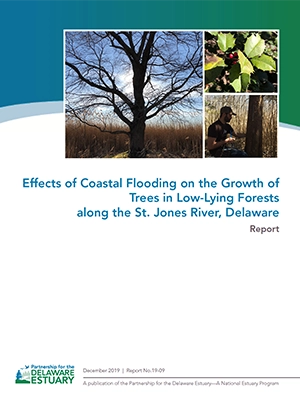Abstract or Summary

Accelerating sea level rise, and the increase of associated environmental stressors such as increasing flood intensity, is a major concern along the Mid Atlantic coast. Along the coast of Delaware, long-term sea level rise, exacerbated by geologic subsidence (forebulge collapse; Engelhart et al. 2011), is increasing locally by 4-5 mm yr-1 (NOAA). This rate may exceed 10 mm yr-1 by the end of this century (Callahan et al. 2017). Additionally, recent reports show that nuisance high tide flooding is becoming more frequent (Sweet et al. 2018). Given that one third of the United States population resides in coastal areas (NOAA 2013), tracking how sea level rise will continue to shape coastal environments and their resilience, or the capacity to recover from change, is integral to the well-being of millions of citizens and the health of their local economies.
As sea levels rise, flooding in low-lying forests will become more frequent. Intertidal marshes are already experiencing increased inundation (Haaf et al. submitted manuscript). Low-lying forests (elevations above MHW but less than 2 m NAVD88) likely flood semi-regularly and during storm events. Flood frequencies will become more recurrent as water levels rise and coastal storms become stronger. As many low-lying trees have limited tolerance to flooding, salt, or both, increased saltwater flooding will eventually lead to tree mortality and forest retreat. The precise mechanisms of ecological change, however, are not well understood due to variability among geographies and tree species.
We can discern how coastal flood exposure affects tree growth through studying patterns in annual growth rings. Previous studies have found that storm surge impacted low-lying loblolly pine (Pinus taeda) growth for three years after the event (Fernandes et al. 2018). Storm surge was also implicated in slash pine (Pinus elliottii) growth reductions up to 6 years following tropical storm flooding along the Gulf coast (Tucker et al. 2018). Thus, tree ring chronologies can provide the necessary information to discern how coastal floods affect low-lying forests.
Sap flow may provide essential context to study tree responses to saltwater flooding as it occurs. Typically, transpiration potential drives rates of sap flow in xylem tissues, but if water loss rates are too high, or if respiration rates at the roots decline, sap flow rates respond accordingly. In this sense, tree vulnerability to flooding and sea level rise can be assessed by monitoring how sap flow changes in response to flood events. For instance, Krauss and Duberstein (2009) found that bald cypress trees reduced sap flow rates to adapt to perennial salinity intrusion, which might act to reduce salt-driven mortality. Reduced sap flows limit the transport of nutrients, so these reductions likely have consequence to tree growth. The relationships between salt exposure, sap flow reductions, and resultant deficient growth convey the susceptibility of a tree to mortality after coastal flooding.
As storm surge and sea level rise become more challenging issues, understanding the effects of salt water inundation in low lying uplands is critical to management decision making. Studying tree exposure and responses to coastal flooding will help managers identify forests with the highest risk of impacts due to surge or sea level rise. The objectives of this study were to i) create growth chronologies of red cedar (Juniperus virginiana) and American holly (Ilex opaca) in low-lying, frequently flooded forests; ii) investigate climatic and flood exposure (by elevation proxy) influences in tree growth records; iii) monitor sap flow in a frequently flooded red cedar; and iv) map low-lying forests in the St. Jones River watershed to help define coastal flood exposure.